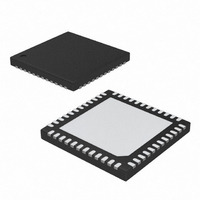MAX16031ETM+ Maxim Integrated Products, MAX16031ETM+ Datasheet - Page 16

MAX16031ETM+
Manufacturer Part Number
MAX16031ETM+
Description
IC SYSTEM MON EEPROM 48-TQFN
Manufacturer
Maxim Integrated Products
Type
Multi-Voltage Supervisorr
Datasheet
1.MAX16032ETMT.pdf
(41 pages)
Specifications of MAX16031ETM+
Number Of Voltages Monitored
8
Output
Open Drain or Open Collector
Reset
Active Low
Reset Timeout
Adjustable/Selectable
Voltage - Threshold
8 Selectable Threshold Combinations
Operating Temperature
-40°C ~ 85°C
Mounting Type
Surface Mount
Package / Case
48-TQFN Exposed Pad
Manual Reset
Resettable
Watchdog
No Watchdog
Supply Voltage (max)
14 V
Supply Voltage (min)
2.9 V
Supply Current (typ)
3000 uA
Maximum Power Dissipation
2222.2 mW
Maximum Operating Temperature
+ 85 C
Mounting Style
SMD/SMT
Minimum Operating Temperature
- 40 C
Lead Free Status / RoHS Status
Lead free / RoHS Compliant
EEPROM-Based System Monitors
with Nonvolatile Fault Memory
The MAX16031/MAX16032 contain both I
JTAG serial interfaces for accessing registers and
EEPROM. Use only one interface at any given time. For
more information on how to access the internal memory
through these interfaces, see the I
Serial Interface and JTAG Serial Interface sections. This
data sheet uses a specific convention for referring to bits
within a particular address location. As an example,
r15h[3:0] refers to bits 3 through 0 in register with
address 15 hexadecimal.
The factory-default values at power-on reset (POR) for all
EEPROM locations are zeros. POR occurs when V
reaches the undervoltage lockout (UVLO) of 2.8V. At
POR, the device begins a boot-up sequence. During the
boot-up sequence, all monitored inputs are masked from
initiating faults and EEPROM contents are copied to the
respective register locations. The boot-up sequence
takes up to 1.81ms. Monitoring is disabled for up to 16s
past the boot-up sequence by programming r5Bh[3:0]
(see the Miscellaneous Settings section). RESET is low
during boot-up and remains low after boot-up for its pro-
grammed timeout period after all monitored channels are
within their respective thresholds.
The MAX16031/MAX16032 monitor up to eight voltages,
up to one current, and up to three temperatures. After
boot-up, an internal multiplexer cycles through each
input. At each multiplexer stop, the 10-bit ADC converts
the analog parameter to a digital result and stores the
result in a register. Each time the multiplexer completes a
cycle, internal logic compares the conversion results to
the thresholds stored in memory. When a conversion vio-
Table 2. Input Monitor Ranges and Enables
16
REGISTER
ADDRESS
______________________________________________________________________________________
17h
ADDRESS
MEMORY
EEPROM
Detailed Description
97h
2
C/SMBus-Compatible
Getting Started
BIT RANGE
2
[1:0]
[3:2]
[5:4]
[7:6]
C/SMBus and
IN1 Voltage Range Selection:
00 = 5.6V, 01 = 2.8V
10 = 1.4V, 11 = Reserved
IN2 Voltage Range Selection:
00 = 5.6V, 01 = 2.8V
10 = 1.4V, 11 = Reserved
IN3 Voltage Range Selection:
00 = 5.6V, 01 = 2.8V
10 = 1.4V, 11 = Reserved
IN4 Voltage Range Selection:
00 = 5.6V, 01 = 2.8V
10 = 1.4V, 11 = Reserved
CC
lates a programmed threshold, the conversion is config-
ured to generate a fault. Logic outputs are programmed
to depend on many combinations of faults. Additionally,
faults are programmed to trigger a fault log, whereby all
fault information is automatically written to EEPROM.
The MAX16031 provides eight inputs, IN1–IN8, for volt-
age monitoring. The MAX16032 provides six inputs,
IN1–IN6, for voltage monitoring. Each input voltage
range is programmable through r17h[7:0] and r18h[7:0]
(see Table 2). Voltage monitoring for each input is
enabled through r1Ah[7:0] (see Table 2). There are four
programmable thresholds per voltage monitor input: pri-
mary undervoltage, secondary undervoltage, primary
overvoltage, and secondary overvoltage. All voltage
thresholds are 8 bits wide. Only the 8 most significant
bits of the conversion result are compared to the
thresholds. See the Miscellaneous Settings section to
set the amount of hysteresis for the thresholds. See
Table 1 for an address map of all voltage monitor input
threshold registers.
ADC inputs are configurable for two different modes:
pseudo-differential and single-ended (see Table 3). In
pseudo-differential mode, two inputs make up a differ-
ential pair. Psuedo-differential conversions are per-
formed by taking a single-ended conversion at each
input of a differential pair and then subtracting the
results. The pseudo-differential mode is selectable for
unipolar or bipolar operation. Unipolar differential oper-
ation allows only positive polarities of differential volt-
ages. Bipolar differential operation allows negative and
positive polarities of differential voltages. Bipolar con-
versions are in two’s complement format. For example,
DESCRIPTION
Voltage Monitoring












